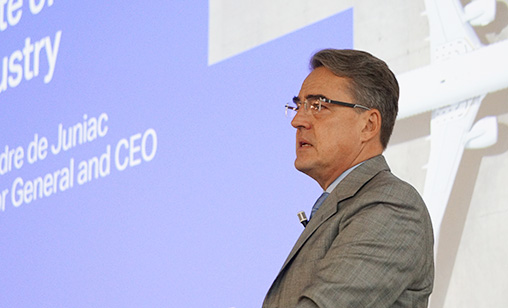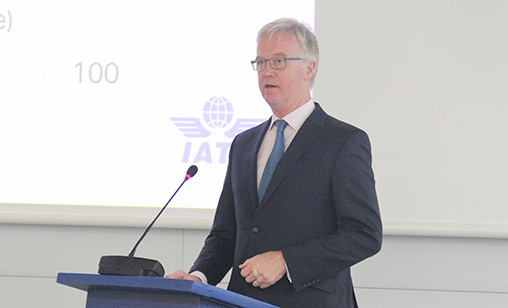IATA 2019 Global Forecast
IATA forecasts lower fuel costs for coming year
December 1st 2018
The world’s airlines are cautiously optimistic about their profit prospects for 2019 and they don’t believe the global economy will be threatened by a recession despite Sino/U.S. political tensions and consequent volatility in financial markets, said the International Air Transport Association (IATA) at its year-end global media briefing this month. Read More »
Speaking to industry media in Geneva on December 12, IATA director general and CEO, Alexandre de Juniac, said net profit for the world’s airline industry in 2019 is expected to be $35.5 billion, slightly ahead of the forecast of a $32.3 billion net profit in 2018. In June this year, the 2018 global airline profit was revised downwards from $33.8 billion. In 2019, Asia-Pacific carriers are expected to report a $10.4 billion net profit, up from $9.6 billion in 2018.
 |
Forecast net profit per passenger in the region is $6.15, which would result in an average net margin of 3.8% across the geographic area. The Asia-Pacific is a diverse market, IATA said, with strong growth from new LCC entrants but it also is a market where some airlines are very dependent on outbound cargo from key manufacturing centres to stay in the black. “Cargo revenue growth has slowed from the strong performance of 2017, but it remains positive for airlines in the region,” IATA said.
De Juniac said lower oil prices and solid albeit slower economic growth of 3.1% were ahead for the global industry in the next 12 months following a squeeze in profitability from rising costs this year. IATA said 2019 would be the tenth year of profit for the industry and the fifth consecutive year that airlines will deliver a return on capital that exceeds the industry’s cost of capital.
“We had expected rising costs would weaken profitability in 2019, but the sharp fall in oil prices and solid GDP growth projections have provided a buffer. We are cautiously optimistic that the run of solid value creation for investors will continue for at least another year. But there are downside risks as the economic and political environments remain volatile,” he said.
Overall, industry revenues are expected to reach $885 billion, an increase of 7.7% from $821 billion in 2018. Passenger numbers for the year are forecast to climb to 4.59 billion, up from 4.34 billion in 2018. The average net profit per departing passenger is estimated to be $7.75 next year compared with $7.45 in 2018. Cargo tonnes carried should reach 65.9 million from 63.7 million tonnes this year.
De Juniac said: “with a 4% net margin, the first point to emphasize is 2019 is basically a similar performance to 2018. Given the gloom in the markets, this may be a surprise to some. But demand is strong and we have seen a major drop in oil prices.”
“The second point to be made clear is the buffer between profit and loss is thin. A dollar for a new tax, an increase in charges or a shift in the oil price can eat away at the $7.75 per passenger profit very quickly.
“We are in a different league for example from Apple. It makes $400 for every iPhone XS sold. Governments should not view the industry’s better financial footing as a blanket bill of health. Nor a blank check”
The aviation industry is on a more solid financial footing than at any time in its history “but to keep delivering the economic and social benefits that only aviation can, it needs a business friendly policy framework,” de Juniac said.
 |
| 'Analysis by economists at Citigroup showed an escalation of U.S. tariffs to 25% in January 2019 would cut global growth by 0.3%. It would not stop growth. They also modelled a more extensive trade war between the U.S. and China which would cut 0.5% from growth, but again it would not, on its own, stop the expansion' |
| Brian Pearce IATA chief economist |
Given the fuel price was a major concern for airlines in the last 12 months, the upbeat outlook from IATA certainly comes as a surprise. IATA’s chief economist, Brian Pearce, said there have been suggestions there will be a recession in 2019, which would be bad news for the airline industry.
He pointed out financial markets had risen substantially from 2016. “Although equity prices have fallen 8% this year they are still 20%-30% higher than they were in early 2016. This is consistent with good corporate earnings and an expansion, not recession,” he said.
Pearce said the major short-term positive for the airline industry is that fuel, airlines’ second largest cost after labour, fell sharply in the last month. “The expectation is Brent crude oil prices will stay in the $60-$70 a barrel range for the next 12 months,” he said. “Our assumption for 2019 is $65 a barrel, which is significantly lower than 2018’s price of $73 a barrel.”
The full benefit of lower oil prices will not be felt across the industry in 2019 because of the impact of hedging at some airlines. The global airline fuel bill in 2019 is forecast to be $200 billion, representing 24.2% of average operating costs., IATA said.
But there is still a lot to worry about, Pearce said. “Protectionism and the U.S. imposition of trade tariffs on China and threats on others are issues for the industry. Aviation depends on open borders and itself facilitates the free movement of people and goods. Border frictions are bad news for aviation and the economic development it brings.”